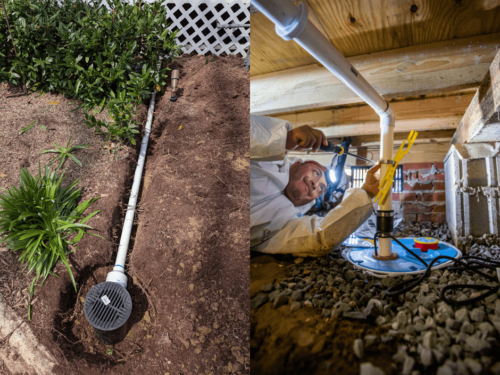Your home’s foundation needs to be strong and stable to support the weight of your home. A strong foundation on stable soil can last for many years. Unfortunately, weak soils, excess moisture, and other factors can cause your foundation to sink and shift over time.
Signs of foundation settling after summer can creep up in various parts of your home. Paying attention to these and knowing what to do if you notice any can mean the difference between catching the problem early and more expensive repairs down the line.
Signs of a Settling Foundation
There are several signs of house settling you can look for to give you a leg up in taking quick action.
1. House-Shifting Cracks
One of the most common signs of foundation settling is wall cracks. Different wall materials will suffer from different kinds of house-settling cracks.
Typically, foundation settlement shows up as stair-step cracks in brick and concrete block walls. The cracks will follow the spaces between the blocks and may get wider as the house settles more.
Meanwhile, drywall cracks often appear as diagonal cracks originating from the corners of doors and windows.
Nail pops may appear on any level of your home. They tend to be most noticeable in ceilings.
In unfinished areas of your home, you may see cracked and bowed foundation walls. Lack of drainage, pressure, and soil movement can exacerbate this sign.
2. Doors and Window Problems
As your foundation settles, doors and windows can shift out of position. The shifts could lead to cracks between the frames and your wall.
Crooked windows and doors could also become harder to open and stick as the frames are not level anymore.
3. Moisture Issues
Moisture issues are also common signs of foundation settling. As foundation cracks allow water in, these issues may pop up in and around your home.
Musty smells, mold, and uneven floors can indicate moisture problems in basements and crawl spaces. Pests that prefer wet spaces and can enter your home via foundation cracks may also increase in these areas.
Standing water around the house can be a sign of foundation settling and worsen it. Ensure rainwater can effectively travel away from your home’s foundation with proper drainage systems.
4. Leaning or Cracked Chimney
Another common sign of a settling foundation is an increase in chimney problems. They may begin as small cracks in the chimney, eventually causing the chimney to separate from your home. Chimneys tend to have a separate foundation, meaning they are more at risk of settlement.
If your chimney starts to lean, it’s a clear sign of a sinking foundation. A leaning chimney can turn into a collapsed one, so take action quickly by seeking professional foundation repair services.
5. Uneven Floors
You may notice uneven, sagging, or warped floors as your foundation settles. Moisture problems, shifting soil, and even failing structural pieces can all contribute to this.
How To Repair Your Settling Foundation
Unfortunately, the consequences of a settling foundation can be severe and even impact the structural integrity of your home. If you notice any of these signs of foundation settling, getting professional help is important. A professional can inspect your home to find the root cause, which can be tricky to determine.
Foundation repairs often involved dealing with problematic soils and using specialized foundation repair products like pier systems. These are not tasks you can do yourself. By working with an experienced professional, you can ensure your foundation is stable and safe.
Pay Attention to the Signs of Foundation Settling After Summer
Whether you notice house-shifting cracks, uneven floors, or moisture problems, taking quick action can help stabilize your home and give you peace of mind. A professional inspection and foundation repair plan are the first steps in ensuring your family’s safety.
Concerned you’re seeing signs of foundation settling around your Virginia Beach, VA, home? Call Virginia Foundation Solutions at 757-340-0917 to schedule your free, no-obligation inspection.







